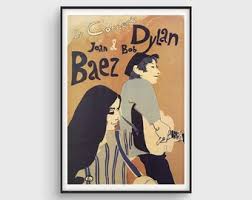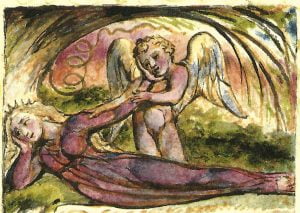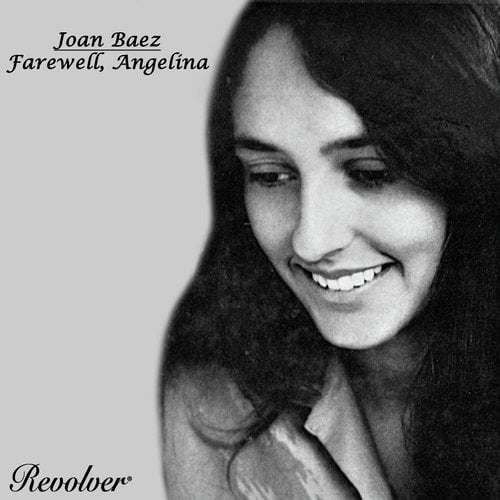Farewell Angelina is one of Bob Dylan’s most remarkable ‘unreleased songs’. Dylan’s own rather uncertain take was recorded during the Bringing It All Back Home sessions in 1965 but not released until The Bootleg Series Vol. 1 (1991). The song was then passed to Joan Baez, who recorded it as the title track of her 1965 album. She performed the song frequently in concert over many years. Dylan himself has never played it live. Perhaps he considered that the song’s highly striking abstract and evocative imagery was most suited to Baez, whose her crystal clear ‘angelic’ delivery elevates the piece. Written around the end of 1964, around the same time as his experiments with transcendent visionary poetry such as Gates of Eden and Mr. Tambourine Man, it is profoundly influenced by the work of the English Romantics and the French symbolists. It also strongly recalls the evocation of dream-landscapes in surrealist art. As in Desolation Row (1965) Dylan invites us into a kind of alternative world which exists in parallel to our own. But is this as earthly paradise or a kind of hell?

Like many of Dylan’s early songs, Farewell Angelina is built around both the tune and the spirit of a traditional melody; in this case the Scottish nineteenth century whaling song Farewell to Tarwaithie, which featured in the repertoire of folk song collector A. L. Lloyd and ‘folk guru’ Ewan MacColl and became a standard for many Scottish and Irish folk singers. Dylan may well have first heard it as performed by The Clancy Brothers. It is a winsome if rather fearful song in which the dangers of whaling in the icy wastes of the seas around Greenland are recounted, despite which the brave sailor is so desperate that he is prepared to risk everything. Earlier in his career Dylan had reshaped the traditional lament Lord Franklin, another tale of the dangers of sailing in icy wastes, into Bob Dylan’s Dream – a song of regretful nostalgia and a profound meditation on the vagaries of human experience over time. Here he again exploits the aching sadness of the traditional melody, while the narrator takes us on different kind of journey into inner consciousness, pouring out a stream of evocative dream images.

Farewell Angelina, like the earlier My Back Pages, shows us an artist in transition from the direct ‘finger pointing’ songs of his early career to the visionary poetic landscapes of his much-celebrated 1965-66 period. It is perhaps ironic that he may have considered the style of ‘folk queen’ Baez more appropriate to the song than his own. But Baez’s recording of the song was also part of her own transformation from a performer of traditional material into an interpreter of contemporary songs. On the album she uses backing musicians (including guitarist Bruce Langhorne, who plays on Bringing It All Back Home) for the first time. By the time she records the song, the lyrics have been considerably sharpened, presumably by Dylan himself, who seems to have shaped the song to Baez’s needs, shortening it by excluding the least effective verse about a ‘camouflaged parrot’ and honing the imagery. Baez’s singing reveals her mastery of the form of the traditional folk ballad. Although the lyrics become increasingly darker as the song continues, her perfectly consistent purity of tone is relatively unvarying. In her hands the song becomes a creation of unique and startling beauty.

The character of ‘Angelina’ herself is a kind of chimera. She has no apparent substance. Although she is referred to at the beginning of the song and in each chorus, there is little indication that the narrator is addressing a lover. ‘Angelina’, which is derived from the Greek term for ‘messenger’, appears to be more like a state of mind which the narrator expresses the need to move on from. Many poets have addressed symbolic ‘angel’ figures in their works. In Charles Baudelaire’s Réversibilité the ’angelic object’ of the poem is portrayed as the personification of the immortality which humans can never reach:
…Angel, teeming with loveliness, do you know wrinkles,
The fear of growing old, and, like a poisoned potion,
The dread of seeing love turn into fond devotion
In eyes adored, once blue and pure as periwinkles?
Angel, teeming with loveliness, do you know wrinkles?… (transl. Jacques Le Clerc 1958)

In some of the most memorable lines in Shakespeare’s Hamlet, the eponymous hero cries in
frustration:
… What a piece of work is man, How noble in reason, how infinite in faculty, In form and moving how express and admirable, In action how like an Angel, In apprehension how like a god… (2:2)
Angels are often used as poetic symbols of perfection. Yet, as in Hamlet’s cry of despair, they are frequently invoked to symbolise the imperfection of humanity. In William Blake’s The Angel the narrator is a ‘maiden Queen’, being protected by a male angel who soothes her pain. Yet the presence of the angel remains a carefully guarded secret:
…And I wept both night and day,
And he wiped my tears away;
And I wept both day and night,
And hid from him my heart’s delight….

William Blake The Angel
Angels thus often stand for the perfect condition which human beings might aspire to, but will always fail to reach. ‘Angelina’, however, suggests a rather diminutive, even shrunken, version of such a flawless state. It is a state of mind which the narrator desperately needs to escape from.

The song begins with a series of resonant images: …Farewell Angelina, the bells of the crown/ Are being stolen by bandits, I must follow the sound… The bells of the crown suggests not a real king but a jester, whose ‘mock crowns’ often had bells attached. There may be a hidden allusion to King Lear’s ‘wise fool’. The narrator, like Lear, is being ‘led by the nose’ into a world of potential madness. As the Fool tells Lear:
…All that follow their noses are led by their eyes but blind men, and there’s not a nose among twenty but can smell him that’s stinking. Let go thy hold when a great wheel runs down a hill, lest it break thy neck with following it…
Thus the narrator’s motivations are already in question. Throughout the song, arresting visual images are juxtaposed against evocations of sound. There is more music to come: …The triangle tinkles, the trumpets play slow…. provides us with two audible cues. The verse is full of alliteration of ‘b’ and ‘s’ sounds, while the clear sound of the triangle is counterposed against what may well be a funeral march. ‘Bandits’ appears to shift us into a more modern ‘Western’ setting, possibly that of Mexico. We then get the first of a series of changing choruses, each of which begins with the song’s title and ends with a slightly delayed rhyme: …Farewell Angelina, the sky is on fire/ And I must go… In each chorus ‘the sky’ will fulfil a different action. As the song becomes more and more surreal the sky will become increasingly personified as a ‘character’ who will become more and more antithetical to the world represented by ‘Angelina’. The reference may suggest that the narrator must leave Angelina’s ‘paradise’ to confront ‘the real world’, which is literally ‘alive’ with potential dangers. Or perhaps it is Angelina’s world which is actually on fire, making the narrator’s departure even more necessary.

In contrast, the second verse begins fairly prosaically, with the narrator addressing Angelina with a sense of zen calm: …There’s no need for anger, there’s no need for blame/ There’s nothing to prove, everything’s still the same… It is clear now that Angelina herself is not responsible for his restlessness. This is followed by one of the song’s most resonant images: …Just a table standing empty by the edge of the sea… a surreal image such as might appear in the paintings of Magritte, or the films of Ingmar Bergman. Despite this scene of apparent calm, we then hear that …the sky is trembling/ And I must leave… Everything in Angelina’s world appears fixed, unchanging. It is as if we are being led through a spookily unruffled and eerily calm landscape. But the sky, which perhaps represents Angelina herself, is ‘trembling’, perhaps in fear or perhaps in anticipation. Or maybe the sky represents the narrator himself, as his thoughts and feelings are made manifest in the physicality of this dream world.
In the third verse, Angelina’s world becomes populated by various shifting figures. In a surreal twist which borrows from Alice’s Adventures in Wonderland, Dylan ‘brings alive’ a number of playing cards. It is a trick he will repeat in songs like Lily, Rosemary and the Jack of Hearts (1975) and Huck’s Tune (2006). We hear that …The Jack and the Queen have forsaked the courtyard… and later we are very memorably taken to …the space where the ace and the deuce once ran wild… The playing cards, which seem to represent the spirit of chance, are in fact noticeable by their absence. Dylan’s cunning use of internal rhyme (…space/ace…) is nicely juxtaposed against the slyly conversational …I’ll see you in a while… Meanwhile …fifty two gypsies now file past the guards…. This apparently random image is the first hint that we are actually in a very dark place. It appears that the narrator is imposing images onto Angelina’s world, as his mind races through various scenarios. The line may suggest an imminent slaughter in a concentration camp (gypsies, along with Jews and gays, being major Holocaust victims). It seems that the paradisiacal world in which spontaneity and randomness are allowed to ‘run wild’ has been replaced by darkly ominous forms of social control. The sky, we are informed, is now …folding… The old order is collapsing.

There is more suggested violence in the following verse. In a rather surreal historical juxtaposition, we see a group of ‘cross eyed pirates’ …shooting tin cans with a sawn off shotgun… while the unidentified neighbours clap and cheer this rather pointless pursuit. We hear that …the sky’s changing color/ And I must leave fast… There is, it seems, little time left. Angelina’s world is crumbling in front of our eyes. In the final two verses Dylan illuminates this collapse with a series of luminous visions. The fifth verse is one of Dylan’s most extraordinary collocations of imagery: …King Kong, little elves, on the rooftops they dance/ Valentino-type tangos, while the make-up man’s hands/ Shut the eyes of the dead not to embarrass anyone…. The initial images are drawn from a mixture of old movies and fairy tales. In the classic (and much remade) 1933 movie King Kong, the monstrous but ultimately sympathetic giant ape is unceremoniously and tragically murdered by shots from countless biplanes, while bestraddling that great symbol of Ameerican ‘progress’ the Empire State Building. The bizarre image Dylan creates here of King Kong dancing ‘sexily’ with the elves is ominous, especially as Kong meets his end on a rooftop.

What follows are some of Dylan’s most evocative if frankly scary lines, which in themselves could be stark monochrome images drawn from old silent movies. Imagine, for instance, a close up of the ‘hands’ and then ‘the eyes of the dead’ being closed. It seems that the vision of paradise – of ‘angel land’ – has now disintegrated. The ‘make-up man’s hands’ might be seen as an evocation of evil state control, as the eyes of the dead are shut to ‘avoid embarrassment’, perhaps after a brutal war. Or perhaps the whole scenario in the song is merely some kind of ‘art house movie’. Then we get the killer lines …Farewell Angelina, the sky is embarrassed/ And I must be gone… The doubled emphasis on ‘embarrassed’ is highly striking. Although the authorities try to hide the carnage they have created, there is no hiding place from the omniscient character of ‘the sky’. In its own way, the word ‘embarrassed’ is more cutting than words like ‘shocked’ or ‘devastated’ because of its connotations of official hypocrisy. It is a sky, perhaps, from which a Hard Rain will soon fall.

In the final verse the mad chaos of conflict has taken over Angelina’s land. But finally this morphs into a strangely comic vision of the chaos of a ‘fallen world’: …The machine guns are roaring and the puppets heave rocks… followed by the rather ominous …And fiends nail time bombs to the hands of the clocks… The ‘puppets’ and ‘fiends’ may appear to be cartoonish characters, but we are left with a troubling climax to the dream-vision. In the final chorus the singer declares: …Call me any name you like, I will never deny it… Dylan may be suggesting that he himself is ‘Angelina’, or perhaps that ‘Angelina’ is the part of his own personality that he is rejecting, because of the need to engage with a more complex and contrary world than that conveyed in his earlier, more strident, ‘message songs’. Ironically, the figure who embodies that kind of idealistic consciousness more than any other is Joan Baez. After the final farewell we hear that Angelina’s world is facing destruction: …the sky is erupting…. Then the narrator makes his exit into another world: …I must go where it’s quiet… To a place of contemplation, perhaps… or an escape from brutal political realities and contradictions.
The song has been recorded by a number of other artists. Interestingly, a number of these inflect the song with the tropes of different forms of country music. The New Riders of the Purple Sage, with former Byrd Skip Battin on vocals, recorded a heartfelt version in 1976 with prominent steel guitar. John Mellencamp’s 1997 version is backed by prominent violin. Tim O’Brien delivers a slightly bluegrass-flavoured version on his 1996 album of Dylan covers Red on Blonde. The song has also been performed live by Rosanne Cash. The yearning, elegiac qualities of the song seem to lend themselves to such stylisations. But Baez’s version is liable to remain definitive. She delivers it ‘straight’ without attempting to twist the complex emotions within it for dramatic effect. Her version is one of her outstanding recordings, marked by the sheer clarity of her delivery, making the luminous poetry of the lyrics – which she delivers with absolute clarity – prominent. Although it was never taken up and developed by Dylan it remains an important marker in his career, representing a moment in which he embraces and celebrates his poetic and musical influences with new confidence.
DAILY DYLAN NEWS at the wonderful EXPECTING RAIN
THE BOB DYLAN PROJECT- COMPREHENSIVE LISTINGS
STILL ON THE ROAD – ALL DYLAN’S GIGS



Leave a Reply